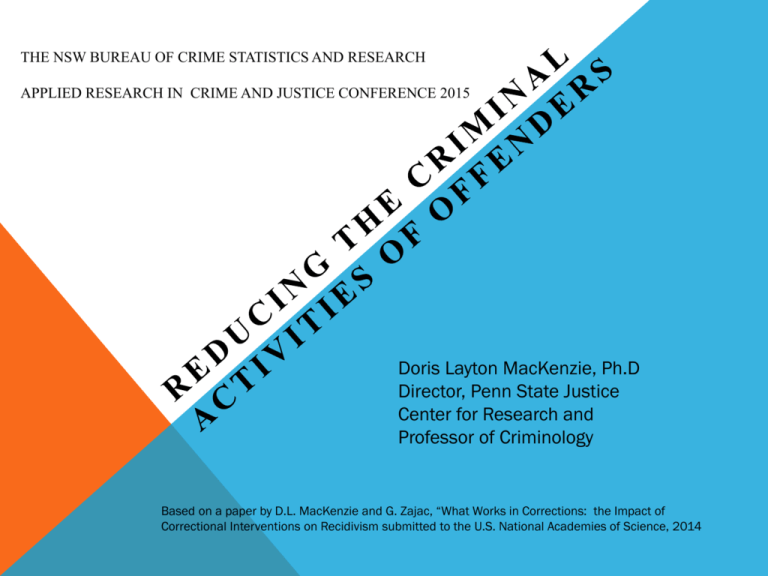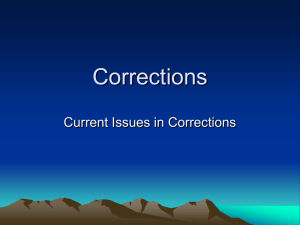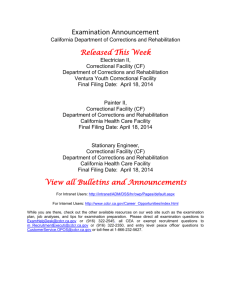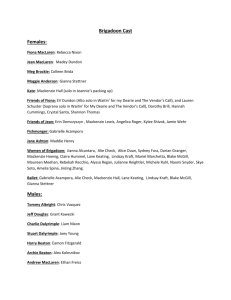Reducing the Criminal Activities of Offenders
advertisement

THE NSW BUREAU OF CRIME STATISTICS AND RESEARCH
APPLIED RESEARCH IN CRIME AND JUSTICE CONFERENCE 2015
Doris Layton MacKenzie, Ph.D
Director, Penn State Justice
Center for Research and
Professor of Criminology
Based on a paper by D.L. MacKenzie and G. Zajac, “What Works in Corrections: the Impact of
Correctional Interventions on Recidivism submitted to the U.S. National Academies of Science, 2014
REDUCING THE CRIMINAL ACTIVITIES OF OFFENDERS
OVERVIEW
Changes in correctional philosophy in the U.S.
Impact of changes
Evidence-based corrections
Improvement in quality of research
What Works to reduce recidivism
Fidelity and implementation
1975: LIPTON, MARTINSON AND WILKS STUDY FOR
NEW YORK CORRECTIONAL SYSTEM
What Works?
“(with) few and isolated exceptions the rehabilitative
efforts that have been reported so far have had no
appreciable effect on recidivism.“
(Martinson, 1974, p25)
WORK WAS WIDELY INTERPRETED AS:
“NOTHING WORKS”
MARTINSON AND COLLEAGUE’S CONCLUSIONS
Inadequate research designs and methods
Poorly implemented programs
Impossible to determine from the
existing data whether anything could
work!!!!!
TIMES WERE RIPE FOR CHANGE
Social upheavals
Civil rights, women’s rights, sexual freedom
War in Vietnam
Corrections: riots in prison, unfairness of the system
Dramatic change in U.S. corrections
Move away from rehabilitation
More punitive, law and order and get tough
Deterrence and incapacitation
CHANGES IN PHILOSOPHY OF
CORRECTIONS
Impact on correctional system
and
What was studied
IMPACT ON CORRECTIONAL SYSTEM
Move away from
rehabilitation,
“Nothing
Works”
Use of
incapacitation
and deterrence
Law and order
philosophy
U.S. Incarceration Rate in
State and Federal Institutions
CHANGES SINCE MARTINSON’S REPORT
Corrections philosophy
Evidence-based corrections
Improvement in quality of research
Emphasis on implementation
CHANGES IN PHILOSOPHY
More punitive
Law and order
Incapacitation
Deterrence
PROGRAMS/ INTERVENTIONS
Correctional boot camps
Longer prison sentences
More prison sentences
Urine testing
Intensive supervision
EVIDENCE-BASED CORRECTIONS
Use of science in decision making
Identify effective correctional programs,
interventions, strategies
Correctional interventions should be those shown
in scientific studies to have the desired impact
WHAT WORKS IN CORRECTIONS?
What have we learned from
the research?
Focus on reducing recidivism
Examined management
strategies, programs,
interventions, treatment
DETERMINING WHAT WORKS
Maryland Report assessments
Quality of research
Significance and direction of effects
Meta-analyses
MARYLAND CRIME PREVENTION
REPORT
Requested by U.S. Congress
Comprehensive evaluation of effectiveness crime
prevention efforts (including corrections)
“What Works, What Doesn’t, What’s Promising”
Sherman et. al.
DECISION MAKING PROCEDURE
2 S TA G E A S S E S S M E N T
1. Assess scientific
quality and
significance
DECISIONS
What works
What doesn’t work
Promising
Don’t know
2. Examine groups
of studies
SCORING FOR SCIENTIFIC QUALITY
Score
Characteristic
1
Very poor quality
2
Association
3
Comparison group
4
Similar comparison group (propensity scoring, controls)
5
Control group/ Experimental design
Randomly assigned
Gold standard
META-ANALYSES
Analysis of a group of studies
Quantitative analysis
Effect sizes
Careful coding of studies
program components
participant characteristics
Quality of research design/ methods
BOOT CAMP META-ANALYSIS EXAMPLE
771 Documents
152 potentially relevant
144 located and evaluated
41 Independent
samples
Analysis
29 eligible studies
41 samples – 14 juveniles, 27 adults
FOREST PLOT FROM META-ANALYSIS: CORRECTIONAL BOOT CAMPS
Favors Comparison
Favors Bootcamp
Fl. Dept. of JJ (Martin Co.), 1997
Farrington, et al., 2000
Fl. Dept. of JJ (Polk Co., Boys), 1997
Jones (FY97), 1998
Jones (FY94-95), 1998
Mackenzie & Souryal (Illinois), 1994
Mackenzie & Souryal (Louisiana), 1994
Jones (FY91-93), 1998
Mackenzie & Souryal (Florida), 1994
Jones (FY96), 1998
Marcus-Mendoza (Men), 1995
Flowers, Carr, & Ruback 1991
Fl. Dept. of JJ (Leon Co.), 1996
Mackenzie & Souryal (Oklahoma), 1994
T3 Associates, 2000
Mackenzie & Souryal (New York), 1994
Peters (Mobile, AL), 1996b
Camp & Sandhu, 1995
Zhang, 2000
Mackenzie & Souryal (S.C., New), 1994
Jones, 1996
Zhang, 2000
NY DCS (88-96 Releases), 2000
Marcus-Mendoza (Women), 1995
Farrington, et al., 2000
Harer & Klein-Saffran, 1996
Kempinem & Kurlychek, 2001
Austin, Jones, & Bolyard, 1993
Burns & Vito, 1995
Peters (Denver, CO), 1996a
Fl. Dept. of JJ (Bay Co.), 1997
Mackenzie, et al. 1997
CA Dept. of the Youth Authority, 1997
NY DCS (96-97 Releases), 2000
NY DCS (97-98 Releases), 2000
Fl. Dept. of JJ (Pinellas Co.), 1996
Fl. Dept. of JJ (Manatee Co.), 1996
Boyles, Bokenkamp, & Madura, 1996
Mackenzie & Souryal (S.C., Old), 1994
Fl. Dept. of JJ (Polk Co., Girls), 1997
Jones, 1997
Thomas & Peters, 1996
Wright & Mays, 1998
Mackenzie & Souryal (Georgia), 1994
Overall Mean Odds-Ratio
.1
.25
.50
.75
1
Odds-Ratio
◊=Central tendency, lines=confidence intervals
2
5
10
IN-PRISON DRUG TREATMENT
Author and Year
PRENDERGAST ET AL 1996
HARTMANN ET AL 1997
TUNIS ET AL (DEUCE) 1995
TUNIS ET AL (JET) 1995
INCIARDI ET AL (CREST) 1997
TUNIS ET AL (REACH) 1995
WEXLER ET AL (MALES) 1990
WEXLER ET AL 1999
TAXMAN & SPINNER 1996
PETERS ET AL 1993
KNIGHT ET AL (ITC) 1999
SMITH 1996
HUGHEY & KLEMKE 1996
WEXLER ET AL (FEMALES) 1990
WA STATE DOC 1998
LITTLE ET AL 1991
EISENBERG & FABELO 1996
ZHANG ('97 COHORT) 2000
PELISSIER ET AL (MALES) 2000
PELISSIER ET AL (FEMALES) 2000
TUNIS ET AL (SAID) 1995
ZHANG ('92-93 COHORT) 2000
OREGON DOC 1994
GRANSKY & JONES 1997
EISENBERG 2001
TUNIS ET AL (NEW BEGIN) 1995
SEALOCK ET AL 1997
DUGAN & EVERETT 1998
MAGURA ET AL (MALES) 1993
SHAW & MACKENZIE 1992
SIEGAL ET AL 1997
MAGURA ET AL (FEMALES) 1993
N
64
244
264
150
359
159
594
715
528
420
396
495
394
285
676
152
1067
200
1842
473
374
854
240
415
5746
166
520
117
149
256
726
100
Favors Comparison
Favors Treatment
Overall Mean Odds-Ratio
.1
.25
.50 .75 1
Odds-Ratio
2
5
10
25
QUALITY OF RESEARCH
Many more experiments (random assignment) since Martinson’s
report
Experiments with offending outcomes
35 from 1957-1981 (Farrington)
83 from 1982-2002 (Farrington and Welsh)
Most meta-analyses control for quality of research
Some meta-analyses use only randomized trials
IMPROVEMENT BUT STILL RELATIVELY FEW
RANDOMIZED TRIALS
284 Studies at scientific method score of 2 or
higher
Only 14.8 % of the studies scored “5”
23.2 % scored “2” – too low to use to
determine “What Works”
USING META-ANALYSES TO DETERMINE WHAT WORKS
Comprehensive or theoretical meta-analyses
Large number of studies
More inclusive in eligibility criteria
Support for various theoretical perspectives
Identify general principles of treatment and effectiveness
Intervention-specific meta-analyses
Focus on specific types of programs, strategies or interventions
Clearly define
Does the particular type of intervention reduce recidivism?
Campbell Collaboration
COMPREHENSIVE META-ANALYSES OF
CORRECTION INTERVENTIONS
Programs that follow the proposed principles (Andrews and Bonta 2006) are more
effective than others
Behavioral, skill-oriented or multimodal programs are more effective than other types of
programs (Andrews, Bonta, Gendreau, Lipsey 1992, Losel 1995)
Therapeutic rehabilitation programs more effective than punitive approaches (control
and deterrence) (Lipsey and Cullen 2007; Lipsey 2009)
Programs targeting high risk offenders are more effective (Lipsey 2009)
Well implemented programs are more effective (Lipsey 2009)
INTERVENTION-SPECIFIC ASSESSMENTS
W H AT W O R K S ?
Drug treatment in community and
prison
Drug Courts
Education
Vocational Ed
Some Sex offender treatment
Cognitive skills programs
NO EVIDENCE, DOES
NOT WORK
Boot Camps
Scared Straight
Correctional Industries
Work programs
Custodial sanctions
Intensive supervision
Life skills
Batterer programs
Electronic monitoring
CLASSIFYING PROGRAMS
Type
Examples
Effective?
Surveillance and control
Electronic monitoring,
Intensive supervision
NO
Deterrence and punitive
Scared Straight
Longer or more prison
NO
Discipline
Correctional boot camps
NO
Services and opportunities
Correctional industries
Work programs
NO
Rehabilitation and skill
building
Cognitive skills
Education
YES
INTERVENTIONS USING “GET TOUGH” OR “LAW
AND ORDER” PHILOSOPHY DO NOT WORK
Surveillance and control
Deterrence and punitive
Discipline
WHY AREN’T PROGRAMS THAT INCREASE
SERVICES AND OPPORTUNITIES EFFECTIVE?
Offenders are not prepared to take advantage
Don’t stop “street life, alcohol/drug use or partying
Don’t get up to make it to work on time
May not get along with others at work
INDIVIDUAL TRANSFORMATION
Offenders must be changed before they are prepared to
take advantage of opportunities in the environment
Individual
Differences
•Attitudes
•Thoughts
•Feelings,
Environmental
Opportunities
•Available
housing
•Employment
•Poverty
(Giordano and colleagues, Maruna, Shover, Farrall)
Behavior
•Criminal
activities
•Prosocial
activities
WE’VE COME A LONG WAY SINCE
MARTINSON
Some programs do work
New and better research techniques
GOOD NEWS
Some interventions/programs work
Increased number of experiments
Emphasis on evidence-based
corrections
BAD NEWS
Many programs/ interventions implemented under “law &
order” emphasis have been shown to be ineffective
Quality of research
Long way to go to reach other fields in number of
experiments
Meta-analyses search through thousands of studies
to find level 3 or above
Fidelity and Implementation still an issue
FIDELITY AND IMPLEMENTATION
Well-trained staff
Principles of effective programs
Dosage
Risk level
Quality control
EFFECTIVENESS AND IMPLEMENTATION
QUALITY
Implementation Quality
Intervention
Effectiveness
High
Low
Effective
Good
Intervention
Poor
Intervention
Ineffective
Poor Intervention
Poor Intervention
MORAL IMPERATIVES
Adequate research designs
Well implemented programs and
policies
Using evidence about what works
THANK YOU
Doris Layton MacKenzie
327 Pond Bldg
Penn State University
University Park, PA
USA
dlm69@psu.edu
814-867-3292
MacKenzie, D. L. (2005). The importance of using scientific evidence to make decisions about correctional programming.
Criminology & Public Policy , 4 (2), 249-258.
MacKenzie, D. (2000). Evidence-based corrections: Identifying what works. Crime and Delinquency , 46 (4), 471.
MacKenzie, D. L. (2001). Corrections and sentencing in the 21st century: Evidence-based corrections and
sentencing. The Prison Journal , 81 (3), 299-312.
Campbell Collaboration. http://www.campbellcollaboration.org/crime_and_justice/index.php
MacKenzie, D. L. (2002). Reducing the Criminal Activities of Known Offenders and Delinquents: Crime Prevention in
the Courts and Corrections. In L. W. Sherman, B. C. Welsh, D. P. Farrington, & D. L. MacKenzie (Eds.), EvidenceBased Crime Prevention (pp. 330-404). London, UK: Harwood Academic Publishers.
Reprinted revised edition 2006, NY: Routledge.
Sherman, L. W., Welsh, B. C., Farrington, D. P., & MacKenzie, D. L. (Eds.). (2002). Evidence-Based Crime Prevention.
London, UK: Harwood Academic Publishers.
Reprinted revised edition 2006, NY: Routledge.






